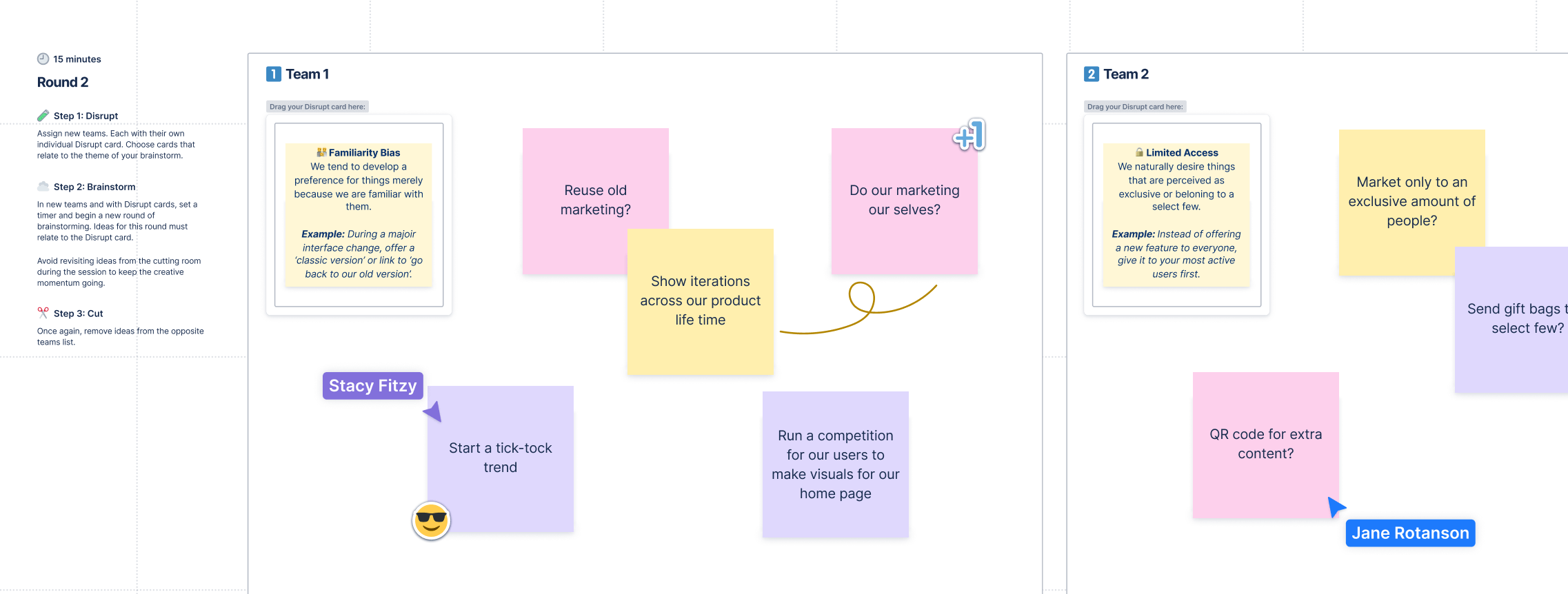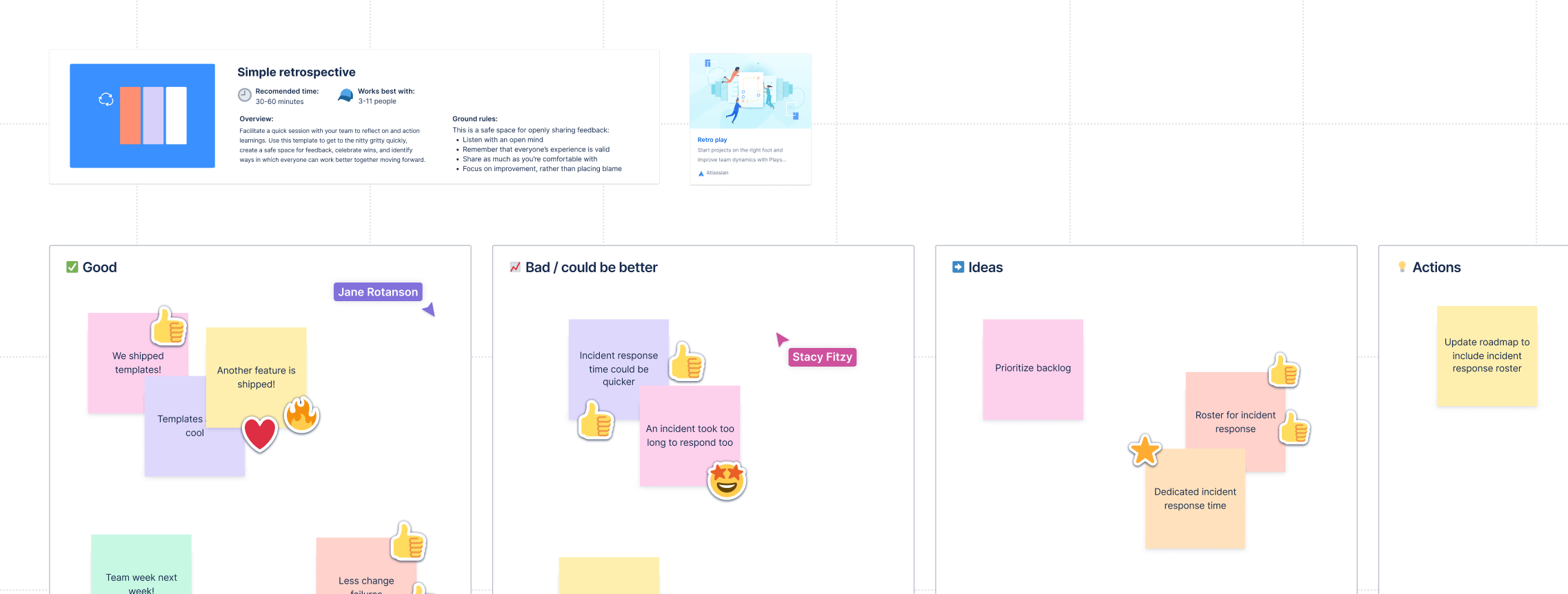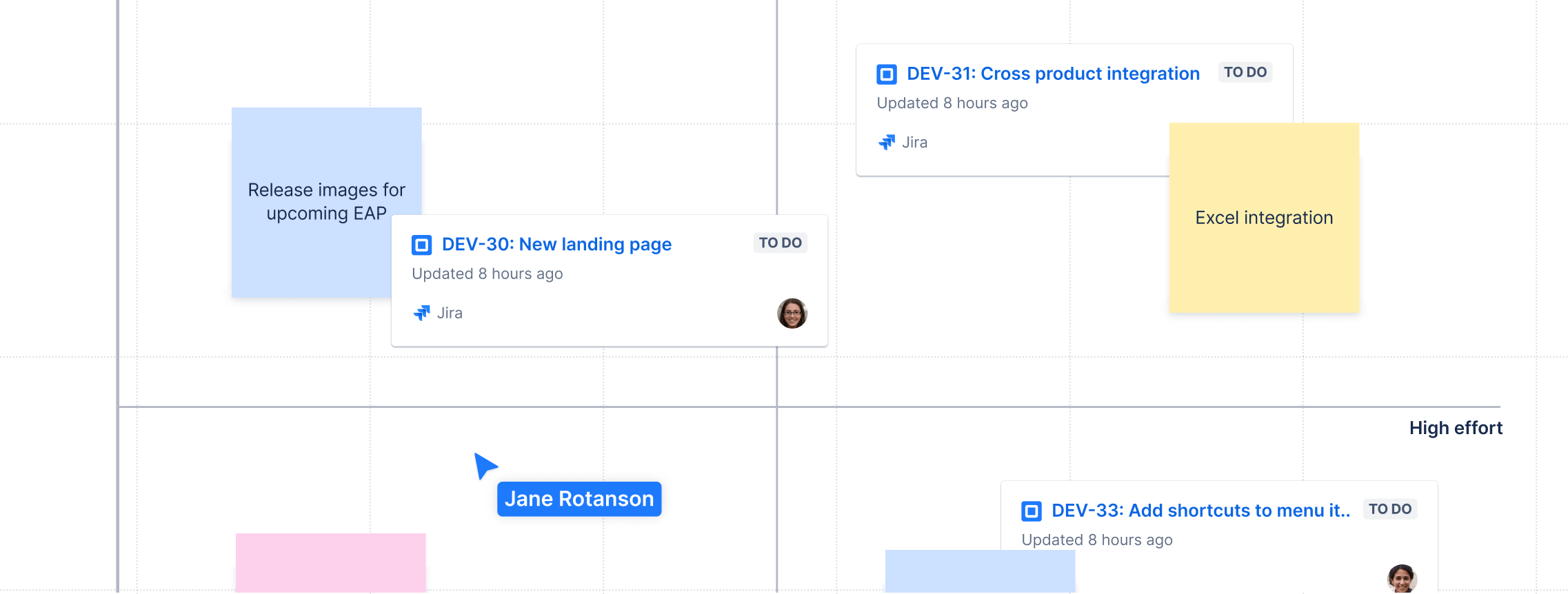Brainstorming com quadros brancos do Confluence
Que de fato crie boas ideias
Buscar tópicos
No método tradicional de brainstorming, pessoas sentadas à mesa de reuniões escrevem várias ideias em um quadro branco com muita rapidez.
Mas as sessões de hoje no quadro branco precisam ser um pouco menos… analógicas. Em 2023, 12,7% dos funcionários em tempo integral trabalhavam de casa — e outros 28,2% trabalhavam em algum tipo de modelo híbrido, de acordo com a Forbes.
No entanto, mesmo nessa cultura de trabalho remoto, a equipe ainda precisa debater ideias. Ainda é necessário usar exercícios de formação de ideias criativas para impulsionar os projetos. Mas não dá para convidar todo mundo para a mesma sala de reunião se alguns dos funcionários mais importantes estiverem em fusos horários diferentes.
A solução: quadros brancos do Confluence.
Com os quadros brancos do Confluence, você vai poder fazer tudo o que faz em um quadro físico — ilustrar com adesivos, conectar com linhas, formular ideias criativas com espontaneidade etc. — e aproveitar as capacidades expandidas de uma solução digital de trabalho remoto. Os quadros brancos do Confluence são sincronizados com o Jira para oferecer colaboração em tempo real ou assíncrona entre funcionários remotos no mesmo quadro.
Pense nisso como tudo o que você adora em um quadro branco real, mas com as vantagens de unificar as sessões de brainstorming da equipe com todas as funções digitais que você possa imaginar. Veja como funciona.
Como funciona o brainstorming em um quadro branco do Confluence?
Os quadros brancos do Confluence reúnem cada ideia de tarefa e projeto em uma única “fonte da verdade”, conectando ideias, planos e tarefas em um único hub no estilo de quadro branco. São todos os benefícios de um quadro branco sem o quadro físico.

Chega de trocar de abas, dispositivos ou computadores, tentando combinar soluções de software com muitos logins e nomes de usuário confusos. O Confluence sincroniza com o Jira, o software de rastreamento de itens da Atlassian, para garantir que cada quadro branco não seja apenas um lugar para jogar ideias. O quadro branco vai ser uma ferramenta real de gestão de projetos ao vivo para organizar como o trabalho é feito.
Ao executar os quadros brancos no Confluence, você vai ter alguns benefícios imediatos na gestão de projetos:
- Uma única fonte de verdade, conectando ideias, tarefas e fluxos de trabalho em um hub centralizado para qualquer pessoa da equipe ver. Colabore com recursos visuais enquanto permite que os membros da equipe adicionem contexto direto ao quadro com anexos.
- Acesso para toda a equipe, criando transparência em cada projeto e permitindo que as pessoas enviem ideias para sessões de brainstorming.
- Economia imediata de custos por meio da consolidação de ferramentas; se você se inscreveu no Confluence, já pode usar os quadros brancos do Confluence.
-
A colaboração virtual aprimorada para maior impacto em toda a empresa. Com os quadros brancos do Confluence, cada funcionário é incluído em reuniões críticas de brainstorming ou dados de fluxo de trabalho para se perguntar onde eles se encaixam no quebra-cabeça de cada projeto. Você também pode usar o Confluence para garantir o acesso de toda a equipe ao quadro branco para facilitar as atualizações.
Como usar o Confluence para um melhor brainstorming
Tudo bem: a gente explicou que o Confluence adiciona todos os tipos de funções à experiência no quadro branco. Mas e o aspecto intangível do uso de quadros brancos: o suco criativo que flui com liberdade na sala de conferências?
Afinal, há mais no quadro branco do que planejar um fluxo de trabalho. Uma boa sessão de brainstorming pode ajudar você a resolver problemas fazendo perguntas melhores.
Como observa a Harvard Business Review, o movimento da psicologia positiva pode remontar a uma sessão de brainstorming. O brainstorming levou a uma pergunta diferente: em vez de julgar a saúde psicológica pela ausência de condições negativas e se condições positivas também impulsionassem o bem-estar?
Ideias criativas como essa podem mudar tudo em uma fração de segundo. A espontaneidade é essencial aqui, fazendo as perguntas hipotéticas que ninguém fez antes.
Como isso influencia os quadros brancos do Confluence e os exercícios de ideação criativa? Conheça as funções a seguir.
Estruture e organize ideias com os quadros brancos do Confluence
As sessões de quadro branco podem ser momentos de criatividade cruciais, é verdade. Talvez uma sessão de brainstorming ajude a equipe a se soltar, dando a todos o impulso de que precisam para liberar as ideias sem medo de que sejam rejeitadas.
Mas os exercícios de ideação criativa têm um limite. Os quadros brancos podem ser ótimos para estruturar uma coleção solta de ideias em uma campanha, um projeto ou uma nova iniciativa.
O problema com os quadros brancos é que pode ser necessário apagar, modificar e fazer um monte de edições muitas vezes. Por outro lado, os quadros brancos do Confluence oferecem assistência digital na hora de organizar as ideias.
- Você pode ilustrar a relação entre ideias com adesivos, linhas e seções, como se você estivesse diante de um quadro branco com uma caneta na mão
Comece a atribuir tarefas e subtarefas do Jira a membros individuais da equipe para sair de uma sessão de brainstorming com muito mais do que só ideias: você sai com uma lista de atividades da equipe
Crie templates e páginas dedicadas para exercícios de brainstorming e ideação criativa
Quadros brancos físicos são apenas isso: um quadro com bastante espaço em branco. Mas os quadros brancos do Confluence podem ser pré-preenchidos com templates de práticas recomendadas, dando a você um ponto de partida para qualquer sessão de brainstorming:
- Os templates de brainstorming vão ser preenchidos com anotações para dar o pontapé inicial daquelas perguntas inovadoras do tipo "e se".
- Os templates retrospectivos vão ajudar a conduzir entrevistas de saída em projetos antigos: vale a pena ver de novo.
- As matrizes de priorização fazem uma divisão em grade no quadro branco para você organizar (e, então, priorizar) as decisões que estão diante da equipe.
- Os guias de formação de equipe são ótimos para atribuir usuários a projetos específicos na organização, o que pode levar a sessões de brainstorming separadas por meio do Confluence.
- Os mapas conceituais podem ser cruciais para mapear recursos de equipe, fluxos de trabalho e planejar vários projetos ao mesmo tempo.
Você não vai perder nenhuma função ao mudar para o quadro branco digital. Notas adesivas? Pode usar. Selos? Você pode usar para reagir e votar nas ideias favoritas. Tudo o que você pode fazer em quadros brancos físicos é possível fazer no quadro branco do Confluence e sem ter que lidar com a barreira dos fusos horários. Vai ser como se todos estivessem na mesma sala.

Sincronize a inspiração da equipe a partir de uma única fonte de informações
A colaboração em toda a empresa é fundamental. Se você não puder ter toda a equipe na mesma sala com um único quadro branco, talvez você sinta que deixou de fora membros da equipe essenciais. O resultado: você não vai poder obter inspiração de ângulos e origens diversas, nem fazer as principais perguntas durante uma sessão de brainstorming.
Mas o Confluence pode mudar isso. Você pode sincronizar novas atualizações com a página inicial do Confluence no automático ou adicionar atualizações específicas dos projetos ao quadro branco do Confluence. A gente também planeja apresentar funções como menções por "@" para garantir que as conversas entre colegas sejam fáceis de fazer referência e serem redirecionadas.
Usar quadros brancos tradicionais pode tomar muito tempo. Com os quadros brancos do Confluence, você pode ter uma sessão de brainstorming virtual e atravessar fusos horários em um piscar de olhos.
Também tem uma função nova para integrar os quadros brancos com o Jira.
Os quadros brancos do Confluence podem ser usados para agrupar um conjunto específico de tarefas, ideias ou atribuições. As seções inteligentes garantem que não seja necessário fazer atualizações nos tickets do Jira depois de planejar as sessões. Você e a equipe podem avançar o trabalho sem ter que voltar e revisar no Jira. Em resumo, você pode ajustar as seções com ações configuradas do Jira, que depois se aplicam a todos os tickets atuais do Jira nas seções. Essa função pode ser usada para atualizar em massa os campos como prioridade, responsável, pontos da história e muito mais.
E também funciona de duas formas. Os membros da equipe podem fazer upload das anotações ou links da web para o quadro branco de forma que elas possam ser consultadas por todos. O resultado: as sessões de brainstorming se transformam em uma lista de atividades com facilidade, igual a uma ferramenta de gestão de projetos.
Integre imagens e links para ajudar a ilustrar e tornar as ideias mais envolventes
Em certo ponto, as funções do quadro branco "analógico" acabam. Você pode colar notas adesivas em quadros brancos, talvez até imprimir e colar imagens neles. Mas quando você tem vídeos, webinars e videoconferências que precisam fazer parte do projeto, nenhum quadro branco vai ajudar.
Bom, exceto um.
O quadro branco do Confluence pode integrar imagens para ilustrar as ideias. Em vez de quadros brancos cheios de longas faixas de texto, imagens podem transmitir ideias com muito mais rapidez. É ainda mais interessante para projetos visuais e com base em design.
Ao criar um quadro branco, você também pode usar essa função para atribuir tarefas aos membros da equipe. Você pode colocar sessões virtuais de brainstorming em destaque para os redatores saberem sobre o que escrever. Você pode oferecer feedback aos designers com gravações de si mesmo dando notas ao vivo. Ou você pode só colar o link de um vídeo que você viu on-line para dar contexto e plano de fundo adicionais para qualquer pessoa da equipe que precise disso.
Comece sessões de quadro branco colaborativas para equipes remotas
Algumas funções nos quadros brancos no Confluence podem ajudar membros de equipes remotas a se manterem informados, mesmo que eles não estejam atualizados sobre a sessão de quadro branco inicial. E a gente ainda nem falou sobre o quanto esse processo pode ser colaborativo.
Com o quadro branco do Confluence, as sessões não se limitam a quem está na sala. Você pode criar uma sessão on-line, seja no computador ou ao vivo em uma sala de conferências e manter todos da equipe remota envolvidos. Você não precisa deixar de lado os membros de outros lugares do mundo nem esperar que eles se atualizem. E você também não precisa perder os insights nem as reações espontâneas deles.
Não se esqueça da importância científica do estado de fluxo. A espontaneidade e as reações ao vivo são importantes para a criatividade. Como um estudo observou, "a possibilidade da surpresa" é um ingrediente essencial para o fluxo. Quando uma boa ideia surge nas sessões de brainstorming, ela estimula a sensação de fluxo na mesma hora.
Esse efeito não pode ser capturado por e-mail com facilidade. Interações e reações espontâneas são importantes para gerar esse fluxo criativo, o que resulta em ideias ainda melhores no quadro branco.
Fazer brainstorming e planejar projetos sem sair do Jira
Se você já usa o Jira, você conhece o poder de oferecer uma única fonte de informações à equipe em cada projeto. Desde o rastreamento de bugs às ferramentas de gestão de recursos do projeto Kanban, o Jira tem tudo o que você precisa para manter os negócios seguindo ao gerar fluxos de trabalho.
Mas passar as sessões de brainstorming para o Confluence pode parecer desafiador. Adicionar o Confluence não causa complicações desnecessárias?
Não da forma que os quadros brancos do Confluence funcionam. O Confluence reúne todo o trabalho em uma única visualização. Você ainda pode usar o Jira como sempre usou. Na verdade, tem jeitos ainda melhores de usar o Jira:
- Converta notas adesivas e formas em tickets do Jira. Uma nota adesiva no quadro branco é um jeito prático de escrever pequenas observações. Com os quadros brancos do Confluence, as notas adesivas podem se tornar muito mais do que simples lembretes. Você pode converter as notas em “tickets” do Jira, o que vai ajudar você a gerenciar o Jira sem sair do quadro branco.
- Conecte os tickets do Jira para mapear o trabalho. E se você tivesse vários tickets do Jira e precisasse ver como eles fluem juntos? Eles também podem ser conectados no quadro branco do Confluence. Ou você pode importar os tickets do Jira para visualizar as tarefas. Às vezes, isso significa preencher um quadro branco com trabalhos de planejamento pré-mapeados já prontos.
- Edite tickets do Jira e páginas do Confluence, de novo, sem sair do quadro branco nenhuma vez.

Com essas funções, você pode integrar os planos e adicionar links conforme a necessidade. É difícil colar um PDF em um quadro branco de verdade. Mas com os quadros brancos do Confluence, você pode ter uma experiência digital completa para todos da equipe remota acessarem.
Promova ideações e inovações criativas com os quadros brancos do Confluence
Pronto para levar o quadro branco para a geração da colaboração digital e consolidação de ferramentas? Não faça apenas brainstorming, faça isso com uma ferramenta que ajude você a transformar cada ideia em muito mais do que uma ideia. Tenha um sistema de gestão de projetos que vai manter o projeto em movimento, a equipe focada nas tarefas e os colaboradores remotos conectados.

